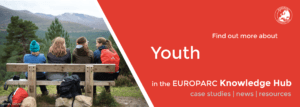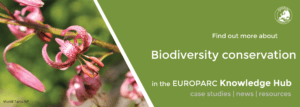10 Good Principles for Outdoor Sports in Protected Areas
On the occasion of the 2019 European Week of Sports, the EUROPARC Federation and the European Network of Outdoor Sports (ENOS) launched simultaneously the 10 Good Principles for Outdoor Sports in Protected Areas (PAs) during their respective Conferences. These Principles aim to promote good conduct among outdoor sports practitioners.
This is the result of a fruitful cooperation of both associations and the first outcome of the Memorandum of Understanding signed last year by EUROPARC and ENOS.
10 Good Principles for Outdoor Sports in Protected Areas
The exponential growth of sport activities in protected natural spaces brings the necessity to structure the way these activities are carried out. At a time when preserving our ecosystems is vital to guarantee a healthy future of nature and people, the Principles aim mainly to lower the impact of outdoor sports on the environment.
Furthermore, these 10 Principles for Outdoor Sports guarantee the maintenance of quality and bring added value to the activities, an aspect that benefits all stakeholders in the sports sector.
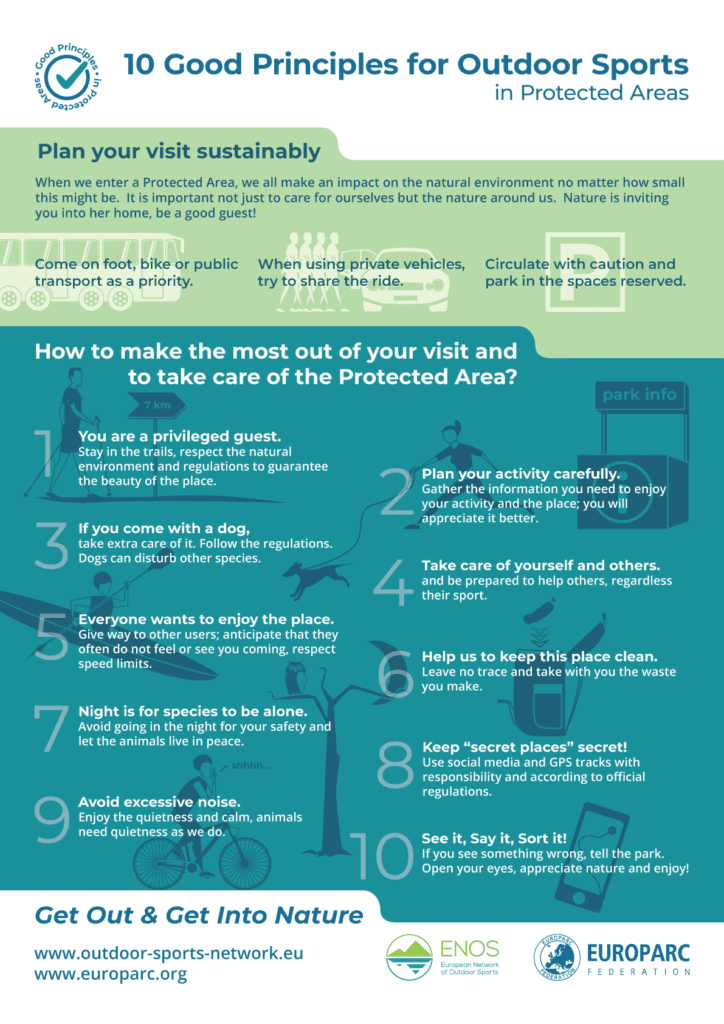
The principles encompass the entire process – from getting to the Protected Area to the delivery of the sport activity itself. Therefore, the interpretation of these principles needs to be carried out in an integral way.
As guests in these natural spaces, we will inevitably create an impact. It is our responsibility to minimise harmful effects, so that we can continue enjoying nature in a harmonious way.
These 10 Good Principles for Outdoor Sports in Protected Areas are the first joint outcome of cooperation between two organisations after they signed the Memorandum of Understanding during the EUROPARC Conference 2018 at Cairngorms National Park in Scotland. More actions will follow to implement the ENOS Charter through a Task Force that integrates the work of both organisations.
Endorse the 10 Good Principles
Now that you know how the principles work, the next step is to back them up. How? It’s very simple! Here are a few examples:
- Show the 10 Good Principles on your website. Visitors who prepare their trips will be better informed.
- Disseminate information on social media. Use your network to spread the word!
- Use your visitor centre to show and talk about the principles during the visits.
- If you organise or participate in an outdoor sports event, make sure participants know the principles before the activity starts.
- When working with young people, teach them and highlight the importance of respecting these principles. Five minutes of teaching can develop into many years of good practice.
- Talk and spread the word to anyone interested, in any way. All diffusion is important!
Remember that although it may be obvious, this behavior when practicing outdoor sports is not so widespread. Any collaboration from your part is very important to treasure our natural heritage.
The 10 Good Principles for Outdoor Sports will soon be launched in different digital formats and languages so that they can be better adapted to the context of each Protected Area. We will also prepare communications material that you can personalise with your Park’s photos and share with your visitors.
The next step in the project will be to go deeper into each sports discipline in order to create principles that are more related and applicable to each activity.
Now it is your turn! Let us know which sports you find the most interesting and important to focus on. Or, contact us with any other suggestion! You can send us your suggestions to a.robles @ europarc.org
Download the 10 Good Principles as a leaflet or a poster
Friends of Protected Areas throw a youth environmental festival
Environmental education Centre “Zapovedniks” organizes the International Forum of the Friends of Protected Areas. It will take place in Russia, Petrozavodsk, between 23 and 26 September 2019.
International Forum as an environmental festival
For the first time, Friends of Protected Areas (FPA), EUROPARC’s youth member association uniting over 600 000 participants from all over Russia, holds their International Forum in the form of an environmental festival. The gathering takes place in Petrozavodsk, the capital of Karelia region bordering Finland, from 23 to 26 September 2019. Running simultaneously to EUROPARC Conference, the General Assembly in Latvia will organize a live video call to get to know their youth counterparts and wish them a fruitful rally.
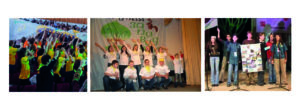 The Forum, organized by the Environmental Education Centre “Zapovedniks”, aims to foster environmental education of children, youth and adults, and to build public awareness on Protected Areas (PA) system. One of the main objectives of the event is to build a common platform for cooperation, share environmental information and experience, and encourage youth to actively lead the way to a sustainable future.
The Forum, organized by the Environmental Education Centre “Zapovedniks”, aims to foster environmental education of children, youth and adults, and to build public awareness on Protected Areas (PA) system. One of the main objectives of the event is to build a common platform for cooperation, share environmental information and experience, and encourage youth to actively lead the way to a sustainable future.
Involving the youth
In the same spirit as EUROPARC’s Youth Manisfesto, the FPA sees the importance of scaling up environmental education and giving youth a voice in tackling environmental issues. This year, the Forum will be held in the framework of the “Decade of Childhood”, declared by the President of the Russian Federation for the years 2018-2027.
The FPA movement aims to educate young and adult people through their involvement in the nature conservation and awareness on Protected Areas.
This year’s special and massmedia guests include, among others, Arctic and Antarctic explorer Dr. Artur Chilingarov, or astronaut Sergey Ryazansky.
Since 2001, the team has organized 6 FPA forums on different places in Russia. The forum is a large-scale environmental education event that gathers active youth, their mentors, protected areas educators and many others who care about nature of our Planet, friends of PAs, including PA volunteers, representatives of responsible business, and others.
For more information and the full programme, visit http://slet.wildnet.ru/.
The Bern Convention celebrates its 40th anniversary
Today, the Bern Convention turns 40 years old. To celebrate this remarkable date, a new campaign was launched to highlight the most inspiring results of 4 decades working for the preservation of nature.
Healthy nature for healthy Europeans
The Bern Convention, first signed on 19th September 1979, was the first international treaty to protect both species and habitats. Today, it celebrates its 40th anniversary with a slogan “Healthy nature for healthy Europeans” and a big awareness campaign.
The initiative reviews the achievements of the Convention through 40 inspiring stories which highlight the essential value this treaty brings for the conservation of our natural heritage.
40 inspiring stories of nature conservation
From helping save the few remaining leopards in the Caucasus to fighting invasive alien species or actively involving citizens in the protection of the environment, the actions of the convention have been turned into engaging stories that are available through the interactive website www.bernconvention40years.com. This initiative highlights the wide reach and long-term objectives of the convention, which has 51 Contracting Parties in 2019.
The campaign encompasses four main pillars of action:
- Protecting biodiversity to maintain the delicate balance between the species in our ecosystems. This is exemplified by results such as the Plan for the Conservation and Recovery of the Osprey, which is helping to bring back this bird to the skies of Southern Europe.
- Tackling environmental challenges such as climate change, invasive species and harmful human activities. The Convention contributes to this ambitious mission with initiatives like Not Alone, a campaign to raise awareness about the key role of biodiversity in counteracting climate change.
- Raising public awareness and actively involving citizens in the protection of our natural heritage. An example of this is the complaint system of the Convention that allows every citizen to raise their voice and report harmful actions against the environment. Since the implementation of this system in 1984, nearly 200 signals and complaints have been processed.
- Preserving our natural habitats and their vital role in hosting numerous species of animals and plants. As a remarkable example, the Emerald Network is an ecological network put forward by the Convention that includes over 3200 areas of special conservation interest in fifteen countries.
#HabitatHeroes Pioneers from the Bavarian Forest National Park
Meet our #HabitatHeroes: Junior Rangers of the Bavarian Forest National Park
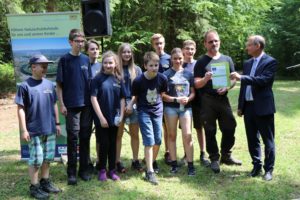
The Bavarian Forest National Park is the oldest national park in Germany. It is a largely forested medium-range mountain landscape which is highly characteristic for Central Europe. Thanks to the Park management that aims to protect natural processes, the forest has seen a successful reintroduction of the ural owl.
Tell us all about your “natural treasure”: Which is the species or habitat you learn and work with the most in your Protected Area?
Founded in 1970, the Bavarian Forest National Park has the task of preserving this valuable region as well as its natural and near-natural ecosystems as a place of natural heritage for current and future generations. The National Park is covered by around 98 percent forest. This includes mixed mountain forests, mountain spruce forests and alluvial spruce forests. In addition, the Bavarian Forest National Park also contains peatlands, open rock faces and historic high-level pastures. In the National Park, the aim is to protect the natural process of genesis, growth and decay. This also includes allowing trees fallen by storms or bark beetles to remain part of the natural cycle. This not only offers extra light, it also adds valuable structure to the forest. As a result, many sometimes highly endangered species can enjoy improved living conditions and/or more abundant sources of food. The gaps in the canopy also ensure that the next generation of forest flora can develop according to its own ancient laws – in turn allowing the pristine forest of tomorrow to emerge.Therefore, the National Park is home to thousands of species.
What is special about it?
One of these species is the ural owl (Strix uralensis). In the area of the Bavarian Forest, the ural owl went extinct in 1925. Thanks to the reintroduction attempts in the Bavarian Forest National Park since 1975, several breeding pairs are again native in the park with numbers steadily increasing. The administration also installed large nesting boxes. The loss of natural breeding opportunities and hunting were the main reasons for the disappearance of the species in the Bohemian Forest. Ural owls need large broken and decomposing tree trunks in mixed mountain forests. Today, these can only be found on a small scale in areas with very old trees. Within the park area, these structures are emerging again and in 1989, the first breeding pair nested on a broken tree trunk. Nevertheless, the national park administration still installs nesting boxes for ural owls which are also used by other bird species.
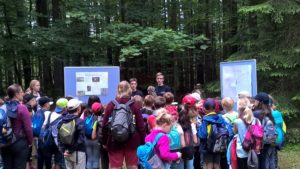
Describe to us what you and your fellow Junior Rangers are doing/will do to learn more and protect your natural treasure. Do you even teach others?
This year marked the 40th anniversary of the EU Birds Directive. To mark this anniversary, several events took place. The National Park hosted an event specially dedicated to the ural owl and the Junior Rangers prepared information material for the guests and politicians.
To do so, we had several meetings before the big event. We started in spring with a calling survey. We met in the evening and discussed the various owls living in the national park and listened to their calls. When it got dark, we drove to various places in the park and played their calls over a loudspeaker, listening for answers. And we were lucky! An ural owl answered.
In the next meeting, we discussed their habitat and built a nesting box for ural owls. The nesting box features three holes one to the front and two at the sides of the box so that the adult owl can look for potential dangers. It also features a mirror on the ceiling of the box so that researchers can have a safe look into the box without disturbing the animals.
Next up, we even got to participate in the ringing of young ural owls! Ringing them helps us identify the individual owls later on.
In the last meeting, we prepared some information material and a plan for the big event.
At the event, we had four stations where we showed the guests the nesting boxes and bird preparations as well as loudspeakers with their sounds and explained about the ural owl and its habitat. We were honoured as NATURA2000 ambassadors and received a certificate for our efforts to inform and protect NATURA2000 habitats and species.
________________________________________________________________
How to learn more and keep track of #HabitatHeroes campaign activities?
Since 2018 we are “mapping the field” and raising awareness for the great work Junior Ranger groups are currently doing for threatened flora, fauna and habitats in Protected Areas and Natura 2000 sites in particular.
- Visit the “Habitat Heroes” campaign website: For now, we are thrilled to introduce you to our Habitat Hero campaign pioneers – groups already taking action. You will find a growing map and overview of Junior Ranger groups.
- Besides, you will meet our “Habitat Heroes” in dedicated articles – make sure you follow our news!
- Keep an eye on social media – the #HabitatHeroes will provide you with exciting updates from our Junior Ranger groups that take part in the campaign. Don’t forget to share their actions!
Want to join the campaign? We are happy to learn about your conservation action – just drop us a mail: f.minozzi@europarc.org
